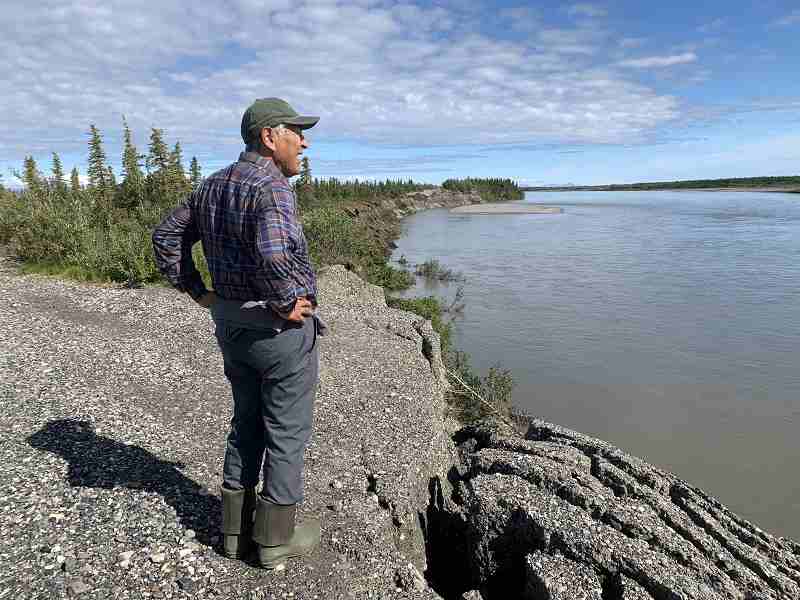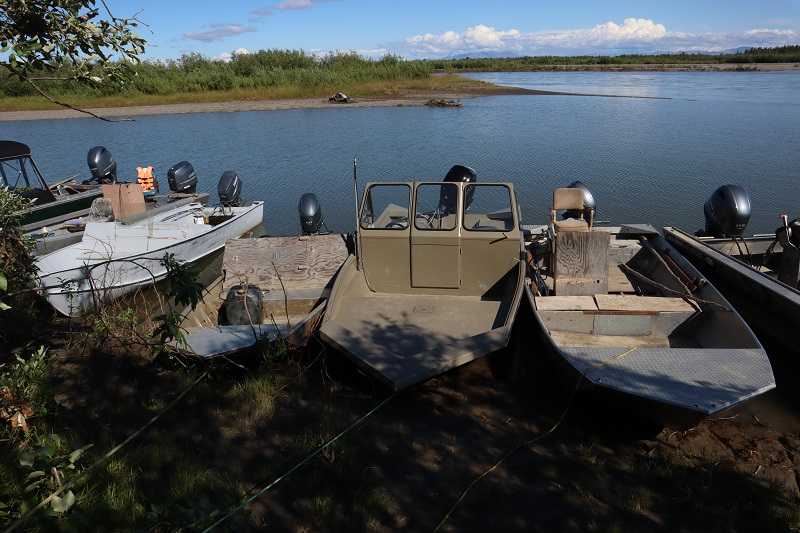
Ricky Ashby, 67, a tribal elder, looks out over the Noatak River. He says he remembers simpler times in his youth when goods and fuel were delivered by barge to the village. The river is now too shallow to accommodate barges.
13:42 JST, September 24, 2022
NOATAK, Alaska – Half a dozen women gather to play Rummikub most summer evenings in a small house on a hill that delivers a southward view of this small Arctic village. There’s lots of laughter and teasing, a nice reprieve from some of the challenges of life in rural Alaska.
In late July, one conversation settled on whether the group could take a weekend boat trip downriver to a place called Sisualik, which means “place that has beluga whales” in the Inupiaq language and is a popular spot to camp, fish and pick berries that sometimes swell to the size of small grapes. The problem, however, was finding enough fuel to power the boat.
In May and June, while other Americans were shouldering the burden of $5-per-gallon gas, residents in Noatak were paying $17.99 a gallon for unleaded and $12.99 for diesel – each about $5 more per gallon than the usual price. The village, which sits 70 miles north of the Arctic Circle, is home to about 570 people. The vast majority of them are Indigenous, and they rely heavily on fishing and hunting for their main food sources. At the only local store, beef steaks shipped in from the Lower 48 states can cost more than $100. A green pepper is priced at $6.59. Those goods and others, such as apples, diapers and butter, as well as diesel and unleaded gas, are all delivered by air.
By mid-July, diesel had become unavailable in the village. The two tanks that store the community’s fuel can hold up to 24,000 gallons, but store employees said that the drums are never filled and that they’re never quite sure when the next delivery will arrive. The fuel – which villagers need to power boats, all-terrain vehicles and snow machines, as well as to heat homes – is delivered by air, and both tanks had run dry for at least the second time this year. Some residents cited mechanical issues with the delivery planes, while others blamed flight scheduling. The planes are limited, and airlines must make sure that a pilot is available and that the weather is safe for flying.
Some people, including Della Luther, decided to find fuel on their own.
“I went to Kotzebue to go get stove oil,” said Luther, 62, who works as a health aide at the local clinic. “Stove oil” is the diesel fuel used in oil-drip stoves for home heating. Luther said her son had the 15 gallons of gas she needed to travel about 70 miles downriver by boat to the larger hub community of Kotzebue, where she bought a 50-gallon drum of diesel for more than $8 per gallon. With the added weight in her boat, she had to buy an additional 21 gallons of unleaded gas to make the return trip to Noatak. Even so, she said it was a good deal.
The gas station in Noatak is a wooden shed that stands alongside a row of metal shipping containers that hold extra dry goods across from the store. Normally, one or two customers might be waiting here to fill their four-wheelers. When fuel finally arrives, store employees said, the line sometimes stretches down the street and past the Noatak Friends Church, which had also run out of stove oil by the last Sunday in July.
“Alappaa!” (“cold” in Inupiaq) Ricky Ashby exclaimed when he returned to his sister-in-law’s house after services that day. Wrapped in a blanket and settled into a sofa with a cup of coffee, Ashby, 67, a Nautaaq tribal elder and a devout Quaker, said it was difficult to concentrate on his morning prayers because the church was so chilly. Noatak is far enough north that even in late July, temperatures at night and into the early morning can dip into the 30s. On this particular Sunday, it was 43 degrees when Ashby unlocked the church door for services at 10 a.m. He said he remembered a much simpler time in this village.
“When I was growing up, there was a building about 40 by 30 [feet]. And in the bottom and upstairs in the attic [was] our whole supply of canned food for the winter,” he said. Ashby added that when he was young, goods and fuel were delivered twice a year by barge from Kotzebue. These days, he said, that much food is delivered by air every week.
Noatak is fairly quiet on Sundays, which residents recognize as a day of rest. On the last Sunday in July, more than 30 boats were docked at the riverbank. That didn’t seem out of the ordinary until midday Monday, at the height of the fishing season. All day, chum salmon announced their arrival with chaotic splashing in the river, but the boats remained tied up, some with nets piled inside. On Tuesday afternoon, most of the boats still hadn’t moved – an unsettling sight in a town that depends so heavily on fishing as a main source of food. At the peak of summer, people also would normally be traveling upriver to cut and haul firewood. This fall, they should be heading out again by boat to hunt caribou, another dietary staple in a community that depends on a subsistence lifestyle.
“It’s just that right now, we’ve got no fuel,” said Hannah Onalik, 67, a tribal elder. “That’s why [the boats] are parked.”
As Onalik talks, two diesel-powered electricity generators, twice the size of a dump truck, hum away at the river’s edge. For her, they’re a reminder of yet another challenge.
“I’m worried. Am I going to have electricity next month? Is my freezer going to work?” she said. As the price of diesel rises, so does her electricity bill. And if her freezer isn’t working, her fish and fresh-picked berries may not last until winter.
Onalik is the tribal council secretary and works as a clerk at the store. She’d like to retire, but she’s the only person in her four-member household with a full-time job. She said she makes $33,000 a year. “I’m going to have to move to Anchorage, where it’s easier,” she said. Because Onalik has a job, she doesn’t qualify for local energy assistance or food stamps from the state. Moving to Alaska’s urban center would be difficult, she said, because she has always lived in Noatak.
“This is home,” she said. “Our food, our fish, our caribou – we would never get those in Anchorage,” which is nearly 600 miles to the southeast. “This is just home, no matter what.”

More than two dozen fishing boats are parked along the river’s edge in Noatak in late July. At the height of summer, people would normally be out fishing for silver salmon, but the village ran out of fuel.
She said a housing shortage in Noatak and the high cost of living have forced some people to move away. The list of reasons to leave may be long, but she also has a reason to stay: “Because, gosh, who would not love Noatak?” As she talked, her gaze moved north, toward a mostly untouched Arctic wilderness and the dark blue ridge line of the Brooks Range in the distance.
Alaska is known for its extensive system of braided rivers, and the Noatak is one of them. In the 1980s, the main channel of the river, which had been separated from the village by a large island, began to shift closer to the community. The water became increasingly shallow, and by the 1990s, barges could no longer travel upriver from Kotzebue to make their biannual deliveries. At the same time, more people were installing diesel-powered heaters in their homes.
In 1989, Teck Cominco started developing one of the world’s largest zinc mines, known as the Red Dog, a few dozen miles to the north. The mine offers jobs with a two-weeks-on schedule for many residents in Noatak, but that cuts into time people might otherwise be out subsistence hunting and fishing.
Ashby said residents who work hunt and fish less often and buy more food from the store. “Some of them, both parents are working just to afford their kids,” he said.
According to the U.S. Census Bureau, the median income in Noatak is $55,000, and only one-third of the working-age population is employed. Cost-of-living data show that in the village, the price of utilities alone is more than 2 1/2 times the national average. Grocery and health-care bills are also above average, compared to those in other communities in the United States.
Many Noatak residents rely on federal benefits to ease the pain of high grocery bills. They also depend on dividends paid out by the state annually. The payments are based on revenue from Alaska’s mineral development and lease sales. This year, qualifying Alaskans are receiving $3,284. The check includes a $650 energy relief payment the legislature approved. Still, it’s not enough for most families in Noatak to get by.
Charlie Barger, 76, said he remembered when five gallons of fuel cost less than $20. He said that was cheap by Noatak standards. But in the past decade, he said, a single gallon has cost at least $10. “Back in the ’80s, we got a barge every summer for stove oil and for groceries for the store,” he said. “Yeah, we used to have barges come up [the river] every summer. Now the water [is] too low.”
Air delivery is more expensive, too. Airplane maintenance, the cost of jet fuel and pilot time all factor into the delivery fees. In addition, the planes that can use small village runways, like Noatak’s, can’t carry as much freight as a barge.
The changes in the Noatak River have not only hindered the village’s ability to receive goods by barge, but they are now threatening the community’s key lifeline: its airport runway. As the river’s main channel changes course, it’s creeping closer and closer to the bank that lies at the south corner of the runway.
In a small back office at the Nautaaq tribal building, Jeff Luther shuffled through photos he has taken over the past three years. In 2020, the riverbank eroded by more than 16 1/2 feet, he said.
“In 2021, we lost 28 feet,” he said. “And then this year is over 60 feet.”
Luther, 40, is the tribe’s environmental program assistant. He said that in recent years, spring rain has been heavy and that more meltwater from farther north has inundated the river and exacerbated the erosion. This year, late summer rain caused the river to swell. In August, Luther said that 12 to 20 feet of riverbank farther south of the village and its runway had collapsed.
“It just depends on how much snow there is and how much water gets into the river,” he said. Luther said he has taken recent measurements showing that only 194 feet of land now stretches between the riverbank and the runway’s edge.
Noatak is the only permanent community nestled along this river. But 100 miles southeast, other Arctic communities on the Kobuk River are also struggling with the high cost of living. The villages of Shungnak and Kobuk have partnered on a multimillion-dollar solar array project that came online in the spring. It could save both communities at least $200,000 in costs associated with diesel-powered electricity generators. Noatak recently received a nearly $2 million grant from the Energy Department for a similar project.
“They were going to come in this month and get the pad and foundation formed,” said Edna Bailey, a tribal administrator. “And then I think next year, they’ll finish the whole thing.” She said she pays at least $700 a month for electricity. Others in Noatak have reported monthly electric bills topping $1,000.
Between the riverbank erosion and the high cost of living, the community is looking for another lifeline. Many residents are turning back to a winter trail used for generations that connects the community to a road that leads to Red Dog Mine. In the winter, they can travel there by snowmachine for less expensive fuel, but they can buy only limited quantities. Noatak’s tribal council is working with the regional government and an Alaska Native Corporation on a plan for a permanent unpaved road along the route. But navigating possible litigation from environmental groups and persuading government agencies to help fund such a project may present yet another challenge.
"News Services" POPULAR ARTICLE
-

American Playwright Jeremy O. Harris Arrested in Japan on Alleged Drug Smuggling
-

Japan’s Nikkei Stock Average as JGB Yields, Yen Rise on Rate-Hike Bets
-

Japan’s Nikkei Stock Average Licks Wounds after Selloff Sparked by BOJ Hike Bets (UPDATE 1)
-

Japanese Bond Yields Zoom, Stocks Slide as Rate Hike Looms
-

Japan’s Nikkei Stock Average Buoyed by Stable Yen; SoftBank’s Slide Caps Gains (UPDATE 1)
JN ACCESS RANKING
-

Keidanren Chairman Yoshinobu Tsutsui Visits Kashiwazaki-Kariwa Nuclear Power Plant; Inspects New Emergency Safety System
-

Imports of Rare Earths from China Facing Delays, May Be Caused by Deterioration of Japan-China Relations
-

University of Tokyo Professor Discusses Japanese Economic Security in Interview Ahead of Forum
-

Japan Pulls out of Vietnam Nuclear Project, Complicating Hanoi’s Power Plans
-

Govt Aims to Expand NISA Program Lineup, Abolish Age Restriction

























